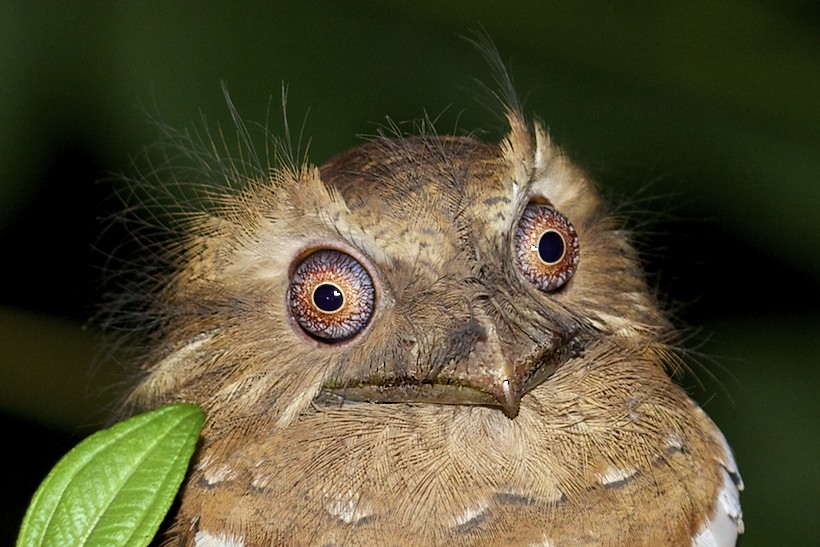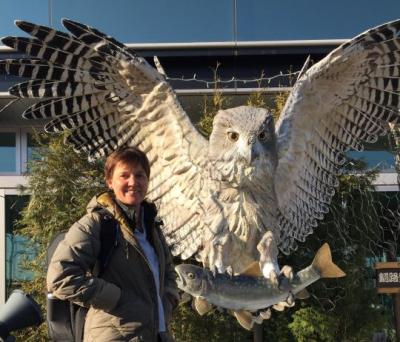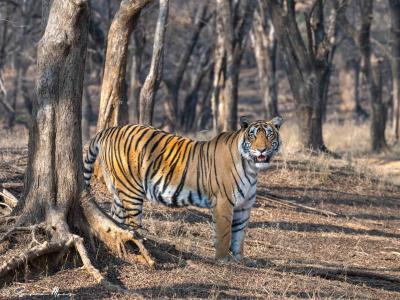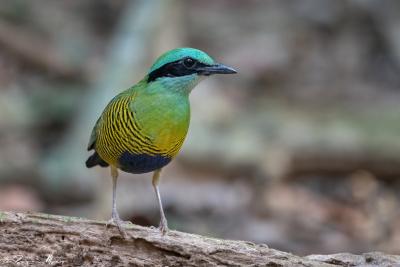Day 1: The tour begins this evening in Manila. Night in Manila.
Day 2: We’ll fly to Puerto Princesa on the island of Palawan. We’ll visit nearby coastal areas for shorebirds and other waterbirds, including the rare Chinese Egret, then drive to the delightful coastal town of Sabang near the World Heritage site, St. Paul’s National Park. Along the last 20 miles of our route we’ll go slowly as we have a good chance for Ruddy Kingfisher, Great Slaty Woodpecker, Palawan Tit, Blue Paradise-Flycatcher, and, at one particular lookout, a slim chance for the highly endangered Philippine Cockatoo. We’ll arrive in Sabang in the late afternoon. Night in Sabang.
Day 3: We’ll spend the day in St. Paul’s National Park and other areas surrounding Sabang. The park is beautifully located between high limestone cliffs and white sandy beaches and is covered in pristine forest. It’s the home of the Underground River, and in the early morning we’ll take a boat directly to its best birding site The area is rich in birds, and there is a good chance of seeing the majority of the endemics and specialties, including Tabon Scrubfowl, Blue-naped Parrot, Palawan Swiftlet, Palawan Hornbill, Hooded Pitta, Yellow-throated Leafbird, Sulphur-bellied Bulbul, Ashy-headed Babbler, Falcated Ground-Babbler, White-vented Shama, Palawan Blue Flycatcher, Lovely Sunbird, and Palawan Flowerpecker. Later in the morning we’ll re-board our boat and return to Sabang. In the afternoon we’ll visit another site with many of these same species as well as Palawan Scops-Owl and Javan Frogmouth, then make our way back to Puerto Princesa. Night in Puerto Princesa.
Day 4: We’ll begin at the Iwahig penal colony, the best place to find the endemic Blue-headed Racquet-tail, as well as Melodious Babbler and Palawan Flycatcher. We’ll also explore the nearby rice paddies and fishponds for wetland birds. In the evening, if permission has been granted, we’ll take a pleasant 30-minute boat trip to an offshore island in search of the very range-restricted Mantanani Scops-Owl Night in Puerto Princesa.
Day 5: We’ll catch an early morning flight back to Manila and then continue by road to the Candaba Marshes and Subic Bay.
The Candaba Marshes are surrounded by rice fields that come alive with birdsong in the early morning. We’ll find elegant Oriental Pratincoles coursing over the fields, as well as Eastern Marsh Harrier, Barred Rail, Asian Palm-Swift, Pied Bushchat, Zitting Cisticola, and Tawny Grassbird. Around the marsh itself we should find Philippine Swamphen, Yellow Bittern, White-browed Crake, Black-winged Stilt, Whiskered Tern, and Pheasant-tailed Jacana, as well as large numbers of Purple and Black-crowned Night Herons. Ducks are often present in large numbers—especially Garganey, Eurasian Wigeon, and Northern Pintail—and lesser numbers of the endemic Philippine Duck.
We’ll bird Subic Bay at the old United States Naval Magazine and the adjacent forest, beginning along a quiet and narrow forest road. Here, we can expect endemics such as the White-eared Brown Dove, Red-crested Malkoha, Black-and-white Triller, Philippine Pygmy Woodpecker, Coleto, and many others. We'll spend the night in Subic Bay.
Day 6: We’ll spend all day birding in Subic’s forests, along the Nabasan road and other areas. Specialty birds could include White-fronted Tit (increasingly difficult but we’ll try…), White-lored Oriole, Sooty Woodpecker, and Blackish Cuckoo-Shrike, and many other endemics can be found as well. Night in Subic Bay.
Day 7: We’ll travel from Subic Bay to Infanta. In a lightly used stretch of the Marilaque Highway, we should find several uncommon endemics, as well as delightful and relatively easy roadside birding in superb forest. We’ll hope to encounter Rufous Hornbill, Great-eared Nightjar, Olive-backed Flowerpecker, Yellow-breasted Fruit Dove, Philippine Trogon, and Philippine Fairy Bluebird among others. Most exciting, we have a good chance of seeing the glorious and uncommon endemic, Flame-breasted Fruit Dove. Night in Infanta.
Day 8: We’ll bird the Marilaque Highway looking in the lush woodland for specialties such as Luzon Sunbird, Yellow-wattled Bulbul, Philippine Cuckoo-Dove, Amethyst Brown-Dove, Crested Honey Buzzard, and so much more. We also have a good chance of finding the scarce and endemic Whiskered Pitta, and we’ll make a special effort to see this attractive ground-dweller. Night in Infanta.
Days 9-10: We’ll begin with a short drive to Mount Makiling. It’s a forested area, managed by the University of the Philippines, on the slopes of an extinct volcano. It hosts a remarkable number of birds including more than 50 endemics and about 2,000 species of flowering plants! We’ll bird mostly along the road, but take side trails both for a change of terrain and a chance to see birds of the forest floor. We’ll look especially for Philippine Serpent-Eagle, Luzon Bleeding-heart (very difficult), Black-chinned Fruit-Dove, Guaiabero, Philippine Hawk-Cuckoo, Luzon Hornbill, Scale-feathered Malkoha, Spotted Wood Kingfisher, Sulphur-billed Nuthatch, Striped-headed Rhabdornis, Gray-backed Tailorbird, Yellow-bellied Whistler, and Striped Flowerpecker. Nights in Makiling.
Day 11: We’ll fly from Manila to Tagbilaran on the island of Bohol. We’ll be met by our driver and go straight to the Rajah Sikatuna National Park for late afternoon birding. Rajah Sikatuna was named after the Bohol chieftain who in 1565 entered into a dubious contract with the Spanish conquistador, Miguel López de Legazpi. The reserve is the largest remaining tract of natural forest in Bohol and one of the Philippines’s top birdwatching sites. It is characterized by rolling hills with remnants of natural forest on limestone terrain, grasslands, and natural springs. It is home to over 120 bird species and two amazing mammals, the Philippines Tarsier, a diminutive primate, and Philippines Colugo, a unique creature sometimes erroneously called a flying lemur. Night in Bilar.
Day 12: We’ll depart early to return to Rajah Sikatuna for the day. Our target birds will be Steere’s Pitta, Visayan Broadbill, Black-crowned Babbler, and Yellow-breasted Tailorbird. Others species we’ll look for include Rufous-lored Kingfisher, Streaked Ground-Babbler, Black-faced Coucal, Blue Fantail, Rufous-tailed Jungle Flycatcher, and Philippine Leaf Warbler. Mindanao Bleeding-heart is a very rare resident, but we have a chance. Either in the early morning or the evening, we’ll search for nightbirds such as Philippine Hawk Owl, Philippine Frogmouth, and Philippine Nightjar. Night at Bilar.
Days 13-14: We’ll take a fast ferry the morning of day 13 to Dumaguete City. We’ll have two days to explore the richly biodiverse island of Negros, aiming to encounter many of its unique endemic birds. We’ll trek through its forests in search of endemics such as the Negros Leaf Warbler, Negros Striped Babbler, and Negros Jungle Flycatcher. Though elusive, the critically endangered Negros Bleeding-heart remains a hopeful target. After sunset, we’ll listen for the calls of the Negros Scops Owl. Additionally, we’ll watch for species bearing the "Visayan" name, referring to birds endemic to the islands of Negros, Cebu, Bohol, Leyte, and Samar. These include the Visayan Hornbill, Visayan Pygmy-Babbler, Visayan Rhabdornis, among others.
Day 15: We’ll bird in the morning and then return to Dumaguete City to catch our flight back to Manila. Night in Manila.
Day 16: The main tour concludes this morning in Manila.
Mindanao Extension
Day 16: We’ll fly to Cagayan de Oro in North Mindanao followed by a four to five-hour drive to the small village of Damitan. Our guides and horses for luggage will meet bur we'll have to walk from here to our lodge, a moderately strenuous hike of around two to three hours, or more if we stop for birding. The lodge has a large open room upstairs for dormitory-style sleeping. All bedding is provided, and large tents are also available. There are basic bathing and Western-style toilet facilities. A delightful local family cooks and caters and will take good care of us. Night on Mount Kitanglad.
Days 17-18: We’ll have two full days to search for Great Philippine Eagle and the 20 or so Mindanao montane endemics. Birding here involves a daily walk uphill on narrow but well-worn trails; much of the area is open and under cultivation. The camp is situated at around 4400 feet, and on at least one day we’ll walk up a little higher in search of such birds as MacGregor’s Cuckooshrike and Apo Mynah. Our primary target will be the eagle, which we have a good chance of finding, and other birds—all endemics—include Bukidnon Woodcock, Giant Scops-Owl, Philippine Frogmouth, Philippine Swiftlet, Yellow-breasted Fruit-Dove, Mindanao Racquet-tail, Philippine Hanging-Parrot, Philippine Nightjar, Blue-capped Kingfisher, McGregor’s Cuckoo-Shrike, Stripe-breasted Rhabdornis, Bagobo Babbler, Rufous-headed Tailorbird, Long-tailed Ground-Warbler, Black-and-Cinnamon Fantail, Mountain Shrike, Gray-hooded Sunbird, Olive-capped, Flame-crowned, and Buzzing Flowerpeckers, Black-masked White-eye, Cinnamon Ibon, Red-eared Parrotfinch, and White-cheeked Bullfinch. Nights on Mount Kitanglad.
Day 19-21: We’ll depart camp after breakfast on day 19 and return to Damitan, where vans will be waiting to take us on the long drive across Mindanao to Bislig and on to PICOP, a large logging concession. Although the forest is disappearing, it’s still rich in birds. Upon arrival, we’ll be met by our local guide, Zardo, and if time allows visit the nearby airport where many wetland birds can be found, including Philippine Mallard, Wandering Whistling-Duck, Philippine Swamphen, Watercock, Black Bittern, and Australasian Grass-Owl. We’ll stay in a small but comfortable and friendly hotel.
We’ll have two days to explore the vast PICOP logging concession. We’ll be traveling in a jeepney, which can navigate the rough roads. It will take up to an hour and a half to get to the birding sites in the morning, and the vehicles will stay with us all day. Among the many fabulous birds that we hope to see are Philippine Hawk-Eagle, Barred Honey-buzzard, Amethyst Brown-Dove, Spotted Imperial-Pigeons, Black-faced Coucal, Silvery and Rufous-lored Kingfishers, and three species of hornbill. Other possibilities are plentiful, so we’ll have much to occupy our time here with birds like Sooty Woodpecker, Mindanao Wattled Broadbill, Steere’s Pitta, Streaked Ground-Babbler, and Rufous Paradise-Flycatcher. There are also several interesting nightbirds in the area, including Chocolate and Mindanao Hawk-Owls. Nights in Bislig.
Day 23: This morning we’ll bird at Bislig before traveling four to five hours to Davao for our flight to Manila. Night in Manila.
Day 24: The Mindanao extension concludes this morning in Manila.
Last updated Dec 30, 2024











































































